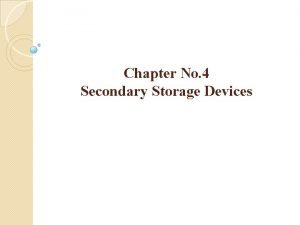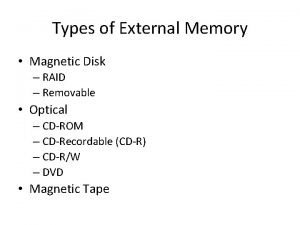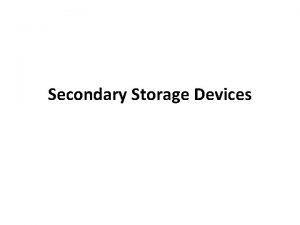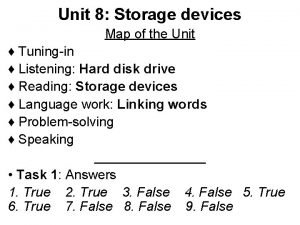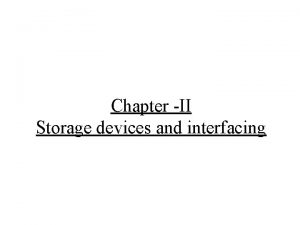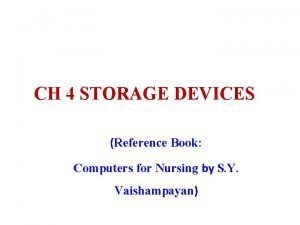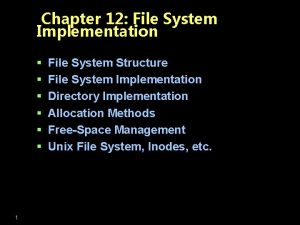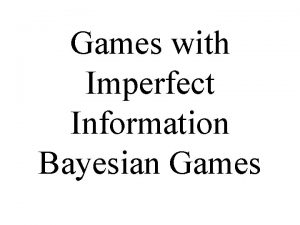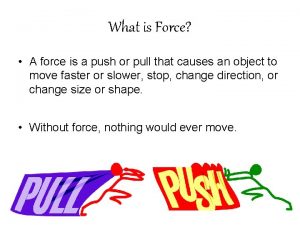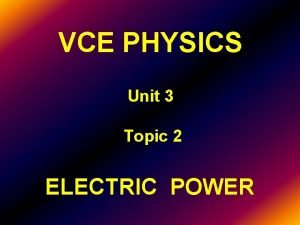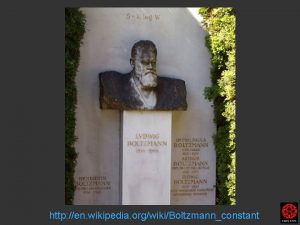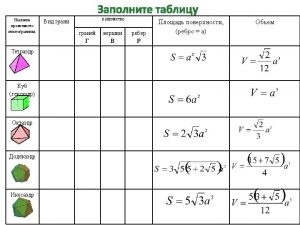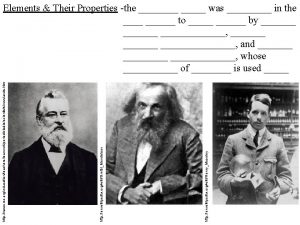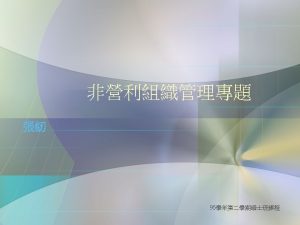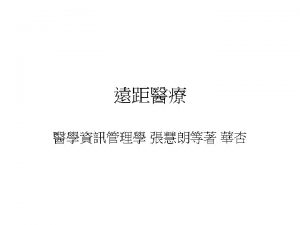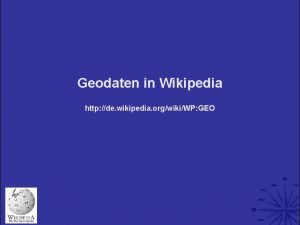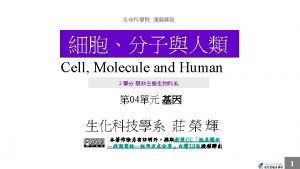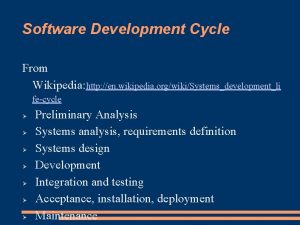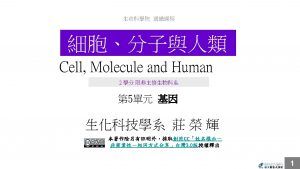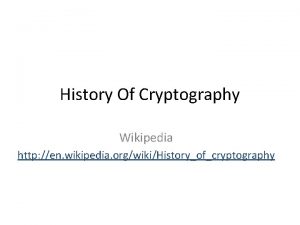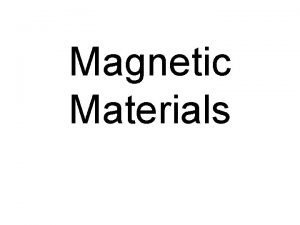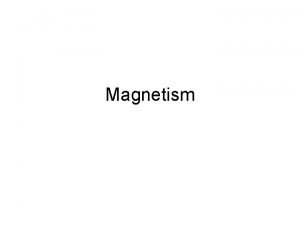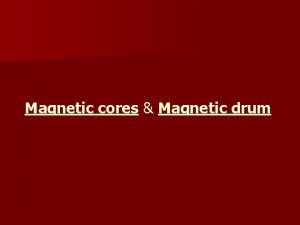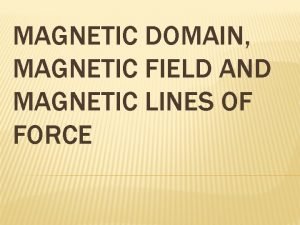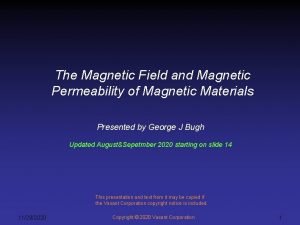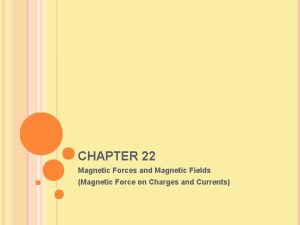Magnetic information storage http en wikipedia orgwikiHarddiskdrive Storage























- Slides: 23

Magnetic information storage (http: //en. wikipedia. org/wiki/Hard_disk_drive ) Storage of information, analog and digital. Storage capacity in magnetic media increases quickly, especially for hard disks (but 8 TB tape-memory has been demonstrated though, http: //www. almaden. ibm. com/st/); worlwide revenues 2012 ~ $38 billion. Storage capacity development (the first digital storage media was developed in mid 50'th): 70'th 80'th 90'th 2010 (Aug. ) 10 Mbit/inch 2 10 -100 Mbit/inch 2 0. 1 -3 Gbit/inch 2 667 Gbit/ inch 2 with perpendicular recording (Samsung). How far can we reach with today's technology? Assume a storage medium consisting of single domain particles, where each single domain particle corresponds to 1 bit, assume further that the particle diameter d = 10 nm ≈ 6 - 7 × 1012 bit/inch 2 with close-packing of particles in a lattice 1/d 2 If the particle separation is too small, Hci decreases because of dipole – dipole interaction, to maintain a high Hci the particle separation should ~ 2×d, yields a storage capacity of a couple of Tbit/inch 2.

Hard disc capacity The first 3. 5″HDD marketed as able to store 1 TB was the Hitachi Deskstar 7 K 1000 (5 platters/ disks). Hitachi has since been joined by Samsung, Seagate and Western Digital in the 1 TB drive market. Hitachi markets a 4 TB HDD (Deskstar 7 K 4000), record holder 2012.

Write/read head only at 10 nm height above surface… In September 2009, Showa Denko announced capacity improvements in platters that they manufacture for HDD makers. A single 2. 5" platter is able to hold 334 GB worth of data, and preliminary results for 3. 5" indicate a 750 GB per platter capacity. The fastest “enterprise” HDDs spin at 10, 000 or 15, 000 rpm, and can achieve sustained disk-to-buffer transfer rate up to 1 Gbit/s.

Today 1 bit corresponds to some hundreds of 5 -10 nm sized grains in a thin magnetic film. Further increase in storage capacity will also require improved methods for reading and storing bit-information. Desired properties of the storage medium I. High Ms and MR, parameter (remanence squareness), reading bit information is made more simple if S is large… II. Hysteresis curve Ms M M Hi Hci MR Hi S* Hci MR M x -MR ideal material real material

Parameter S* (coercive squareness), with S* being large it becomes easier to obtain dense packing of bits, also important with a narrow distribution of S* (homogeneous material). III. Large but not too large Hci , why? However, today T in state-of-art hard disks! Storage media based on single domain particles i) Tape (digital data, audio- and video-signals) and ii) floppy disks (history…) Needle shaped particles (why? ), length 0. 15 - 0. 5 mm, diameter 0. 05 -0. 15 mm. Fabricated by applying a thin layer of a magnetic colloid onto a tape, the long axes of all particles are aligned along the tape direction by a magnetic field, the carrier liquid is then evaporated leaving aligned particles + binder, in the end the tape is pressed to final shape. Non-magnetic g-Fe 2 O 3 Co g-Fe 2 O 3 Cr. O 2 Fe particles, eg. Al 2 O 3, 25 -30 30 -70 35 -70 100 -200 used as lubricant. Volume concentration 0. 42 0. 45 0. 5 2. 1 of particles ~ 40 %. Common particle media size [mm] S/S* l=0. 5 d=0. 1 0. 5/0. 8 860 cubic ferri- l=0. 5 d=0. 1 0. 5 -0. 8/0. 8 860 cubic ferri- l=0. 5 d=0. 05 0. 5/0. 8 390 tetragonal ferro- l=0. 15 d=0. 05 0. 25 -0. 5/0. 8 1050 bcc ferro-

In the TB-tape (tera-byte, IBM), single domain Fe particles of size nm and nm are used, exhibiting a coercivity of k. A/m. iii) In creadit card applications one uses a more hard magnetic material (there is no need to rewrite information); hexagonal ferrites Ba. O-6 Fe 2 O 3, Hci [k. A/m] ~ 200, K 1 ~ 2· 105 J/m 3, plate-shaped crystals, d = 1 mm, t = 0. 02 mm. How small can single domain particles be? Magnetic anisotropy implies energy barrier between different easy axis directions, stabilizes the particle magnetic moment; Eb = K 1 V , where V = particle volume. At 0 K the Stoner-Wohlfarth model applies. Finite temperature, uniaxial magnetic anisotropy z H q m = Ms V y Eb x Energy for particle magnetic moment ;

Probability distribution for m (Boltzmann factors …) where Z is the partition function (sum/integral over all states for the particle magnetic moment), , Characteristic relaxation time / 'flip' time for the magnetic moment m at RT ,

Possible cases (tm = measurement time/storage time) For storage media it is required that t is 10 years (or larger) Storage of information by using micron-sized thin film electromagnet, ferromagnetic core, airgap < 1 mm, in tapes and floppy disks direct contact between read/write head and storage medium, in hard disks there is an air-cushion between storage medium and head when the hard disk rotates. Cubic ferrite, good abrasion properties and high resistivity i N lk lg Ni-Fe, Fe -Co, . . . Permalloy or permendur, high permeability and high saturation magnetization (in comparison with ferrites) soft magnetic ferrite Desired properties of write head: I. High Ms (yields large magetizing fields and high MR in storage medium) and II. low MR , no storage when i = 0

Storing through the horizontal component of the leakage field, but out-of-plane magnetization media are taking over now, more later. Ampere's law The efficiency of storing is given by the ratio between the magnetomotive forces Can also be expressed using the reluctances reluctance = magnetomotoric force / F, eg. Large η(< 1) if mr large and/or if small. The storage capacity in fact depends both on the properties of the read/write head and the storage medium itself, is given as , present status ~ 106 BPI and 105 TPI. Maximum BPI is given by the transition width a between two bits, in a simplified model, the transition region is given as

Slope gives an expression for a, a= 2 M R p = ( M x ) ( M H )( H x ) 1 42 4 3 media write head High bit-density requires both large and large (the magnetizing field should have a large gradient)! i = 0 e Reading can in the simplest case be done using the same magnetic circuit, the storage medium rotates with constant velocity - history though! Good to have ! N v

Today magnetoresistive sensors are used to read stored information in hard disks Giant Magneto. Resistance (GMR) – (magnetic metal / non-magnetic metal)n Nobel price 2007 I. Multilayer each layer a few nm thick II. Sandwich structure FM 1 Me FM 2 Resistance change at much lower fields, DH ~ 10 – 100 Oe

Tunneling Magneto. Resistance (TMR) – magnetic metal / insulator / magnetic metal (Co. Fe. B today)

The different magnetic parts of a hard disk 4 3 2 1 1. 2. 3. 4. Actuator Read/write head Storage medium Electric motor

1. The actuator consists of two parts; i) a Nd. Fe. B magnet consisting of two parts creating a vertical field, directed upwards at one end and downwards at the other end of the magnet assembly, and page 500 in course book ii) a coil shaped as an arrowhed, a current through the coil creates a magnetic field interacting with the field of the Nd. Fe. B magnet assembly and thereby a tangential force that will position the read/write on the disk.

2. Read/write head integrated on slider

In the beginning of 90’th, anisotropic magnetoresistance (AMR) was used; the resistance in a FM is larger when the current is parallel with the magnetization, comparably small effect, ~ 1 -2% R H Today GMR → TMR

3. Storage medium – thin polycrystalline magnetic films Evaporation, sputtering or electroplating to deposit polycrystalline magnetic films, each crystal is small enough to only host a single domain The magnetic film is covered by a thin carbon film and a lubricant to avoid unnecessary abrasion of the magnetic layer. 1 bit of stored information corresponds to ~ 100 nanocrystals. The magnetization in each grain along an easy axis of magnetization. . .

In-plane magnetic storage media Co-P Co-Ni-Pt Co-Fe 36 -96 40 -120 60 -70 60 -120 800 -1100 600 -1000 800 -900 1400 -1600 S 0. 9 0. 8 0. 9 S* 0. 9 0. 8 0. 97 0. 9 Today one uses magnetic films exhibiting larger coercive field Hci ~ 300 -400 k. A/m to stay away from superparamagnetic limit

Smaller bits have been made possible by reducing the size of nanocrystals, signal/noise ratio when reading the information is proportional to number of crystals in one bit of stored information (the magnetization in each crystal along its own easy axis. . . )

PMR - Perpendicular magnetic recording Perpendicular recording can deliver more than three times the storage density of traditional longitudinal recording. Soft magnetic layer!

Ökningen av lagringskapacitet har möjliggjorts genom ett antal förändringar: • Skrivhuvudet har en 'smal' sida som skapar ett starkt och mycket koncentrerat magnetfält i gapet mellan pol-spetsen och det underliggande skiktet av mjukmagnetiskt material. Tjockleken på det mjukmagnetiska lagret 100 - 200 nm. Mellan lagringsmaterialet och det mjukmagnetiska skiktet finns ett tunt (< 5 nm) icke-magnetiskt mellanskikt. Var är magnetkretsens gap nu? • Större skrivfält har gjort det möjligt att använda lagringsmaterial med större koercivfält; idag används tunn Co. Cr. Pt film (tjocklek < 20 nm) med textur (kristallkornens c-axel, lätt magnetiseringsriktning vinkelrät mot filmplanet, storlek kristallkorn ~ 5 -10 nm) och med m 0 Hci ≈ 0. 5 T. • Magnetfälten från närliggande bitar har jämfört med longitudinell lagring inte samma negativa inverkan på lagringskapaciteten. Utveckling sedan introduktionen 2005: 2005 Toshiba 1. 8'' introducerade den första PMR disken 2006 Seagate 3. 5'' kom med PMR diskar (300 GB och 750 GB diskar), samma år kom Hitachi, Western Digital och Fujitsu med egna PMR diskar 2007 kom Hitachi med den första 1 -Terabyte PMR hårdisken 2008 kom Seagate med 1. 5 -Terabyte PMR disk 2009 kom Seagate och Western Digital med varsin 2 -Terabyte PMR disk 2012 Hitachi introducer sin 4 -Terabyte PMR disk

Magnetooptical storage media (storing of digital data) Thermomagnetic storage, focused laser beam ( < mm) on magnetic film, small part heated to a temperature T > Tc or at least to a high enough temperature so that Hci is small, the heated part of the film is then a few m. W laser cooled at the same time as a of power beam magnetic field is applied to store new information. perpendicular magnetization H II. To read stored bit information, one uses the same laser beam but with less power, polar Kerr-effect, implying a rotation of the plane of polarization when the laser beam is reflected at the surface of the magnetic storage medium, ~ 0. 2 o - 0. 5 o Advantages: ü No physical contact with the storage medium during storing/reading of information. Disadvantages: ü Slow in comparison with modern hard disks, üonly medium large storage capacity possible, mini-disks with 1 GB capacity was introduced 2005 by Sony, but today the competition with flash-memories is difficult. Properties of storage medium: üHigh magnetic anisotropy with easy axis perpendicular to film plane, ühigh Kerr-effect, not all materials are suitable, and üTc ~ 100 degrees above RT

Material: Often alloy containing a rare earth element (4 f ) and a 3 d element, 4 f ions yield high magnetic anisotropy but are shielded by electrons in 5 s, 5 p and 6 s electron shells, 3 d ions are only shielded by the 4 s shell and therefore yield large Kerr effect. 4 f - 3 d alloys useful Tb. Fe Gd. Tb. Co 500 30 100 200 0. 25 0. 35 0. 33 400 450 430 650 Mål • Känna till önskvärda egenskaper för magnetiska lagringsmedia • Känna till hur tape-baserade lagringsmedia är uppbyggda • Känna till vad som avses med den superparamagnetiska gränsen • Känna till hur skrivhuvudet är uppbyggt och vilka egenskaper som eftersträvas • Känna till hur man läser information på moderna hårddiskar • Känna till hur lagringsmediat i en hårddisk är uppbyggt • Känna till vad som avses med vinkelrät lagring av bit-information och varför en övergång till denna typ av lagring har inneburit en kraftigt förbättrad lagringskapacitet för hårdisken, känna till vilket material som används
 The coercive force in a ferromagnetic material is
The coercive force in a ferromagnetic material is Magnetic flux density formula
Magnetic flux density formula Magnetic moment and magnetic field relation
Magnetic moment and magnetic field relation Magnetic force particle
Magnetic force particle Drum printer definition
Drum printer definition Fixed-head magnetic disk storage
Fixed-head magnetic disk storage Magnetic tape secondary storage
Magnetic tape secondary storage Unit 10 magnetic storage
Unit 10 magnetic storage Magnetic storage
Magnetic storage Optical storage
Optical storage Rurom
Rurom Http wikipedia org
Http wikipedia org Http //mbs.meb.gov.tr/ http //www.alantercihleri.com
Http //mbs.meb.gov.tr/ http //www.alantercihleri.com Siat.ung.ac.id
Siat.ung.ac.id Primary storage vs secondary storage
Primary storage vs secondary storage Secondary storage vs primary storage
Secondary storage vs primary storage Uses rigid metallic platters
Uses rigid metallic platters Unified storage vs traditional storage
Unified storage vs traditional storage In-memory file system
In-memory file system Emc information storage and management
Emc information storage and management Incomplete information vs imperfect information
Incomplete information vs imperfect information Magnetic force push or pull
Magnetic force push or pull Right hand palm rule magnetic field
Right hand palm rule magnetic field True north vs magnetic north
True north vs magnetic north




